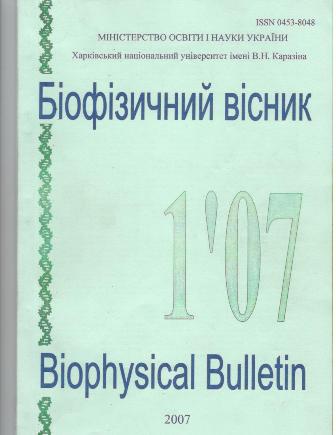Cadmium ion effects on phase equilibrium in double-stranded poly(rA) poly(rU)
Abstract
Differential UV spectroscopy was used to study heating and Cd2+ ion induced conformational transitions in double-stranded poly(rA) poly(rU) (AU) and its components (single-stranded poly(rA) and poly(rU)) in buffer solutions (pH 6.5) containing 0.03M Na+. It was revealed that with the rise of the cadmium ion concentration single-stranded polynucleotides undergo a number of conformational transitions, the character of which is conditioned with the dominant type of the metal complex. The phase diagram of poly(rA)-poly(rU) measured in solution with cadmium ions at 0.03M Na+ is compared with diagrams for AU+Cd2+ at 0.1M Na+ and AU+Mg2+ at 0.01M Na+. It was shown that at low metal concentrations the helix-coil transition in AU is of one-phase cooperative character. When some critical concentration [Mtcr] is reached, the 2—>1 transition is replaced with the disproportional 2AU—>A2U+poly(rA) (2—>3) transition after which the disruption of the triple helix (3—>1) takes place. The [Mtcr] value depends on the sodium ion content in solution: the more the Na+ concentration, the higher concentration of divalent ions corresponds to the triple point. A series of Na+ concentrations ([Na+]= 0.01, 0.03 and 0.1 М) presets such [Mtcr] positions as 4•10-5, 6•10-5 and 10-4М that represent a linear dependence [Mtcr] = f([Na+]) in the double logarithmic scale.The cadmium binding to poly(rA) bases results in the narrowing of the existence region of triple helices (in comparison with that of Mg2+ ions). The Cd2+ ion interaction with O4 of uracil causes the further destabilization of the triple helix.
Downloads
References
Hossain Z, Huq F. J. Inorg. Biochem. 2002;90:97-105.
Hartwig A. Pure Appl. Chem. 2000;72:1007-14.
Kowara R, Karaczyn AA, Fivash M.J.Jr, Kasprzak KS. Chem. Res. Toxicol. 2002;15:319-25.
Joseph P, Lei YX, Whong WZ, Ong TM. J. Biol. Chem. 2002;277:6131-6.
Lei YX, Chen JK, Wu ZL. Teratog. Carcinog. Mutagen. 2002;22:377-83.
Giovannangeli C, Rougee M, Garestier T, Thuong NT, Helene C. Proc. Natl. Acad. Sci. USA. 1992;89:8631-5.
Praseuth D, Guieysse AL, Helene C. Biochim. Biophyss. Acta. 1999;1489:181-206.
Felsenfeld G, Davies DR, Rich A. J. Amer. Chem. Soc. 1957;79:2023-4.
Zenger V. Printcipy strukturnoi organizatcii nukleinovykh kislot. Moskva:Mir; 1987. 584p. (in Russian)
Krakauer H, Sturtevant JM. Biopolymers. 1968;6:491-512.
Krakauer H. Biochemistry. 1974;13:2579-89.
Stevens ChL, Felsenfeld G. Biopolymers. 1964;2:293-314.
Yang L, Keiderling TA. Biopolymers. 1993;33:315-27.
Andrushchenko V, Blagoi Yu, van de Sande JH, Wieser H. J. Biomol. Struct. Dynam. 2002;19:889-906.
Sehlstedt U, Aich P, Bergman J, Vallberg H, Norden B, Graslund A. J. Mol. Biol. 1998;278:31-56.
Sorokin VA, Valeev VA, Gladchenko GO, Degtiar MV, Blagoi YuP. Macromol. Biosci. 2001;1:191-203.
Sorokin VA, Valeev VA, Gladchenko GO, Degtiar MV, Karachevtsev VA, Blagoi YuP. Int. J. of Biol. Macromol. 2003;31:223-33.
Sorokin VA, Valeev VA, Gladchenko GO, Degtiar MV, Rubina AYu, Andrus EA, et al. Biophysical Bulletin. 2001;2(9):45-50.
Blagoi IuP, Galkin VL, Gladchenko GO, Kornilova SV, Sorokin VA, Shkorbatov AG. Metallokompleksy nukleinovykh kislot v rastvorakh. Kiev:Naukova dumka; 1991. 270p. (in Russian)
Aoki K. Nucleosides, Nucleotides and Metal Ions. Elsevier: Amsterdam, Oxford, New York; 1988. P. 457-90.
Gellert RW, Bau R, Martin RB, Mariam YaH. Metal ions in biological system. 1979;8:chapt. 1-2.
Sigel H, Massoud SS, Corfu NA. J. Am. Chem. Soc. 1994;116:2958-71.
Katoh Y, Kuninaka A, Yoshino H. Agr. Biol. Chem. 1975;39(10):1957-62.
Shin YA. Biopolymers. 1973;12:2459-75.
Post CB, Zimm BH. Biopolymers. 1982;21:2133-7.
Yamasaki Yu, Teramoto Y, Yoshikawa K. Biophysical J. 2001;80:2823-32.
Bloomfield VA. Biopolymers. 1997;44:269-82.
Diebler H, Secco F, Venturini M. Biophys. Chem. 1987;26:193-205.
Blagoi Yu, Gladchenko G, Nafie LA, Freedman TB, Sorokin V, Valeev V, et al. Biopolymers. 2005;78:275-86.
Porschke D. Biopolymers. 1971;10:1989-2013.
Authors who publish with this journal agree to the following terms:
- Authors retain copyright and grant the journal right of first publication with the work simultaneously licensed under a Creative Commons Attribution License that allows others to share the work with an acknowledgement of the work's authorship and initial publication in this journal.
- Authors are able to enter into separate, additional contractual arrangements for the non-exclusive distribution of the journal's published version of the work (e.g., post it to an institutional repository or publish it in a book), with an acknowledgement of its initial publication in this journal.
- Authors are permitted and encouraged to post their work online (e.g., in institutional repositories or on their website) prior to and during the submission process, as it can lead to productive exchanges, as well as earlier and greater citation of published work (See The Effect of Open Access).





